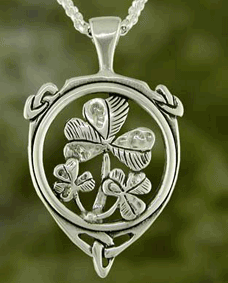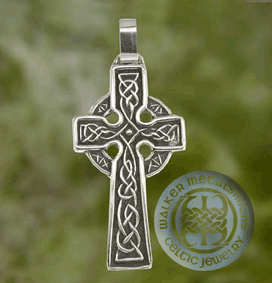
Knotwork History & Symbolism
The first version of this article was posted on a
newsgroup and wound up on the Frequently Asked Questions page of the
Soc.Culture.Scottish Newsgroup. I must point out that the original contains
several errors that are corrected below. From the FAQ page it has been cut and pasted into
many web pages, errors and all. Sometimes I am recognized as the author and sometimes not. If
you have read other web pages on the subject of Celtic interlace and what is
written below sounds too familiar, be assured this is not just another plagiarism. I
am the original author. Stephen Walker 24 March 2000.
Celtic knots or Celtic interlace are ornamental patterns
that first became associated with Celtic people in the early Celtic Church where they were
used to decorate Bible manuscripts, monuments (notably Celtic crosses
and cross slabs) and jewelry. They probably were used in other media such as wood
carving and textiles but these have not survived.
Knotwork tradition in manuscript painting
possibly came to
Ireland in the middle of the 7th century in manuscripts illuminated by Coptic monks from Egypt or
Syria. This is not a settled issue as
far as the art historians are concerned but the best evidence of style, coloring and
methods of construction I have seen points to Middle Eastern prototypes. From Ireland the style
spread to Scotland (in those days Pictland and
Dalriada), Wales and Northumbria and with
missionaries of the Celtic Church to Europe. Viking raiders later appropriated some of the
design concepts into a more chaotic style of animal interlace.
Celtic knots are complete loops with no end or beginning.
Celtic animal interlace is similar in construction but the cords terminate in feet, heads,
tails ect. The animal designs are very much influenced by older Saxon and Pictish
traditions of abstract beast forms that when combined with the new more sophisticated
knotwork of the Celtic designers became known as 'Hiberno-Saxon'. A good Celtic artist
will never leave a loose end on a strand unless it is stylized into a zoomorphic element
or spiral. Pure knots should always be unending. On this point of ornamental grammar you
can distinguish much that is made to look like Celtic design by designers who do not
really know the tradition. The Coptic examples of knotwork that pre-date the early Irish
work are consistent this way while the Roman and Germanic examples of knotwork that
sometimes are cited as possible sources often have loose ends. The way that ribbons are
colored in some of the early Irish work, particularly the BOOK OF DURROW is the same as
the Coptic preference and there is a parallel evolution in Moorish design.
The Book of Kells is the best known source of Celtic knots
as well as other types of Celtic ornament. The Book of Kells is a fantastic collection of
paintings that illuminate the four Gospels in Latin, penned circa 800 AD The incredible
degree of ornament and detail caused Giraldus Cambrensis in the 13th century to call it:
"the work not of men, but of angels" or as Umberto Eco wrote in 1990: "the
product of a cold-blooded hallucination"
In recent years Celtic Knots have enjoyed a revival
however way too much of this has amounted to copies of historical knots used in tourist
type craft goods. Fortunately there are a few artists who take the subject more seriously
and are creating new and exciting knots. Check out:
Patrick Gallagher at http://www.celtart.com
Michael Carroll at http://www.mccelticdesign.com
Jeff Fitzpatrick Adams
http://www.irishcelticilluminations.com/
Alexander Ritchie made quite a lot of very good silver
jewelry incorporating knotwork on the Isle of Iona from 1899 to his death in 1941. George
Bain wrote an excellent book titled CELTIC ART THE METHODS OF
CONSTRUCTION that is great if anyone is serious about learning how to create new knots
in the Celtic tradition. Bain's book was first published in 1951 but appeared as a series
of booklets before that. Aidan Meehan has a series on Celtic design
with
an entire volume titled KNOTWORK.
As for symbolism:
knotwork designs are emblematic in
modern times of the Celtic nationalities. The symbolism that has come down through the
ages is as obscure and indirect as much of the speech and literature of the Celtic people.
How then can we understand it?
If that which is not prose must be poetry, knotwork's
meaning defies literal translation and should be sought at a deeper level. the repeated
crossings of the physical and the spiritual are expressed in the interlace of the knots.
The never ending path of the strand represents the permanence and the continuum of life,
love and faith.
SAW
Click
here for a more scholarly article about the symbolism of Celtic design







